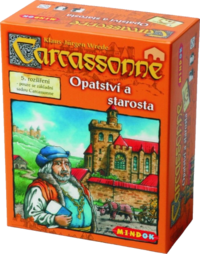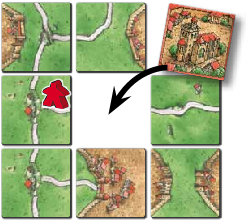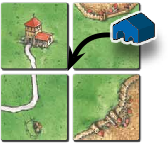Opatství a starosta (původní edice)
 |
Na této stránce najdete pravidla pro takto ilustrované kartičky. |
 | Pokud se vaše kartičky podobají těmto, přejděte na tato pravidla: |
| Pokud grafika na vašich kartičkách vypadá úplně jinak, bude mít jinou spin-off hru Carcassonne. |  |
Mindok |
Úvod
![]() Opatství a starosta je rozšíření k originální
Opatství a starosta je rozšíření k originální ![]() základní hře Carcassonne. Tato stránka popisuje pravidla pro styl původní edice (C1) tohoto rozšíření.
základní hře Carcassonne. Tato stránka popisuje pravidla pro styl původní edice (C1) tohoto rozšíření.
Česká pravidla na této stránce vycházejí z oficiálního překladu od vydavatelství Mindok. Nejnovější pravidla publikovalo roku 2007 jako součást samostatného rozšíření (![]() ID0725). Na této stránce je uveden jejich přepis s korekčními úpravami popsanými na souhrnné stránce:
ID0725). Na této stránce je uveden jejich přepis s korekčními úpravami popsanými na souhrnné stránce: ![]() Poznámky k českému překladu.
Poznámky k českému překladu.
Toto rozšíření bylo vydáno v nové edici (C2) jako ![]() Opatství a starosta a v nové edici (C3) zatím vydáno nebylo.
Opatství a starosta a v nové edici (C3) zatím vydáno nebylo.
Rozšíření je hratelné pouze se základní sadou CARCASSONNE nebo kterýmkoli jiným rozšířením. Všechna pravidla hry zůstávají stejná. Zde jsou popsána pouze dodatečná pravidla k tomuto rozšíření.
Herní materiál
- 12 new land tiles
- 6 abbey tiles
- 6 barns
- 6 wagons
- 6 mayors
Comments on some features present in the tiles of this expansion:
Pravidla
Preparation
At the beginning of the game, every player receives one abbey tile and one mayor, one barn, and one wagon of the player's chosen colour, and places these in his or her supply.[1] With the exception of the following changes, the basic rules for Carcassonne remain unchanged.
Place a tile
The new land tiles are placed in the usual way. [2] [3] [4]
Opatství
Příprava hry
Each player should, at the start of the game, have one Abbey tile in front of them.
1. Přiložení kartičky
Instead of drawing and placing a land tile, a player may instead choose to place his or her abbey tile. [5] The abbey may be placed anywhere that precisely one land tile fits: that is, it can only be placed in a 'hole' in which all four sides are already bordered by land tiles. [6] [7] If there is no such 'hole' available, the abbey cannot be placed. It does not matter what incomplete features appear on the four tile surrounding the "hole".
If one or more players have not placed their Abbey when the last landscape tile is drawn and placed, they may still do so, in clockwise order starting from the left of the person who placed the last tile, as long as it is in accordance with the rules. The game is then over. [8] [9]
Deploy a follower
The player may deploy a follower to the abbey as a monk. [10] [11] [12]
When a player has placed an abbey (and possibly deployed a follower), all four of the adjoining tiles are closed on those sides. [13] [14] [15] All completed roads, cities and cloisters are then scored as usual. [16] [17]
Scoring
Monks in abbeys are scored in the same way as in cloisters.
Final Scoring
Monks in incomplete abbeys are scored in the same way as in incomplete cloisters at the end of the game.
The Mayor

|
Preparation
Each player should start the game with a Mayor of their chosen colour.
Place A Tile
There are no tiles specific to The Mayor, although it should be noted, that city tiles with pennants are of importance to The Mayor follower.
Deploy a follower
The mayor may be deployed instead of a follower. It may only be deployed to a city in which there is currently no knight; [18] [19] [20] [21] [22] the usual rules for deploying followers still apply. [23] [24]
The strength of the mayor, when determining the majority in a completed city, is the same as the number of pennants in the city, or 0 if none.
Scoring
When scoring a completed city, the following is true:
- a normal follower has a strength of one.
- the big follower from
 Hostince a katedrály has a strength of two.
Hostince a katedrály has a strength of two.
The strength of the mayor is the same as the number of pennants in the city. [25] If the city has no pennants, then the mayor has a strength of zero and scores no points for the city. [26] [27] [28] The score of the city is not changed by the mayor. After scoring, the mayor is returned to the player's supply.
The Wagon
Preparation
Each player should start the game with a Wagon of their chosen colour.
Place A Tile
There are no tiles specific to The Wagon.
Deploy a follower
The wagon may be deployed instead of a normal follower. It may be deployed to a road, city, or cloister in which there is no other figure. [29] [30] [23] [24] The wagon may never be deployed to a field segment.
If a feature occupied by a wagon is scored, the wagon counts as a normal follower.
Scoring
If a feature occupied by a wagon is scored, the wagon counts as a normal follower. After scoring, the player may return the wagon to his or her supply, or may move the wagon to a directly adjacent road, city, or cloister. [31] [32] [33] [34] [35]
The feature into which the wagon is moved [36] must be incomplete and unoccupied. [37] If none of the neighboring features are incomplete and unoccupied, the player must return the wagon to the supply. [38] If several wagons are involved in scoring, then each player decides whether to retrieve or move his or her wagon, beginning with the player whose turn it is and continuing clockwise.
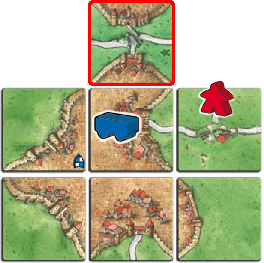
Additional examples
If a wagon is placed in a city completed and scored, the wagon can only move to a road, if this road (uncompleted and unoccupied) is directly adjacent to this city (connected to the city walls through a gate). Since a farm is also an feature, there must be no farm between the road and the city. It does not matter where the wagon is placed within the completed and scored feature (e.g. city) before it moves. Features sharing a surface like an adjacent abbey or a cloister within a city can also be considered as a valid destination for the wagon.
Moving the dragon depends entirely on feature adjacency, not on the initial position of the wagon within the feature completed and scored. Likewise, the wagon can move to any tile of the adjacent feature (the number of tiles the wagon moves is irrelevant).
The following examples illustrate the movement of the wagon in various scenarios.
Example 1. Moving from a completed city
After the city is completed and scored, the wagon moves to an adjacent feature which has to be incomplete and unoccupied.
The city is completed by the surrounding walls and the abbey. The city is adjacent to the several farms, an incomplete road, a short road, and an incomplete abbey. Additionally, there is also an incomplete cloister within the city.
The wagon can move move to:
- The incomplete road (any of its tiles)
- The incomplete abbey
- The incomplete cloister within the city
The wagon cannot move to:
- Any farm adjacent to the city
- Any road not connected to the city through a gate
- The short road connected to the city or any roads connected to it at the junction
- The incomplete road connected to the abbey, since it is not connected directly to the city
- The cloister with the completed road connected to the abbey
- The incomplete city connected through short roads and a junction
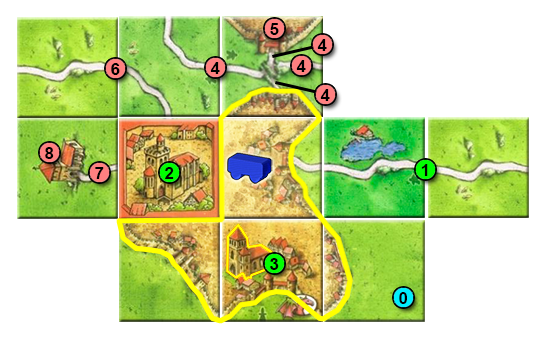
- 0 Tile just placed.
- 1 The wagon can move to this road.
- 2 The wagon can move to this abbey.
- 3 The wagon can move to the cloister within the city.
- 4 The wagon cannot move to the short road ending at the completed city or to any road connected to it through the junction.
- 5 The wagon cannot connect to this city because it is connected through short roads and a junction to the completed city.
- 6 The wagon cannot move to this uncompleted road because it is connected to the abbey, not to the completed city.
- 7 The wagon cannot move to this road because it is completed and connected to the abbey, not to the completed city.
- 8 The wagon cannot move to this cloister because it is directly connected to the completed city; it is connected to a completed road leading to the abbey.
Example 2. Moving from a completed city
After the city is completed and scored, the wagon moves to an adjacent feature which has to be incomplete and unoccupied.
The city is completed by the surrounding walls. The city is adjacent to the several farms and 3 roads. Two roads are completed, so the wagon can only move to the incomplete road at the top.
The tile where the wagon is placed in the city does not affect the possible options. The result is always the same: an adjacent uncompleted unoccupied feature to the city.
Likewise, if the wagon is moved to the incomplete road, it can be placed on any of its tiles.
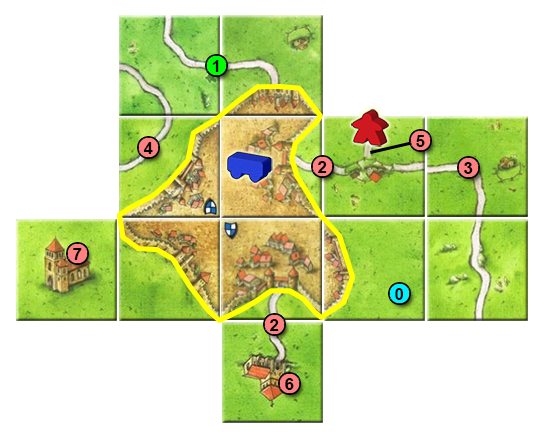
- 0 Tile just placed.
- 1 The wagon can move to this road. It can be placed on any of its tiles.
- 2 These roads are connected to the city but they are completed.
- 3 This road does not border directly at the city wall because it starts at the junction.
- 4 This road does not border directly at the city wall because there is a farm between this road and the completed city.
- 5 This road does not border directly at the city wall because it starts at the junction and it is occupied.
- 6 This cloister is not directly adjacent to the completed city because there is a completed road between the cloister and the completed city.
- 7 This cloister is not directly adjacent to the completed city because it is surrounded by a farm.
Example 3. Moving from a completed road
After the road is completed and scored, the wagon moves to an adjacent feature which has to be incomplete and unoccupied.
The wagon can move to an adjacent feature on any of the road's ends. The number of tiles the wagon moves is irrelevant. It is only important that the feature is directly adjacent to the completed road.
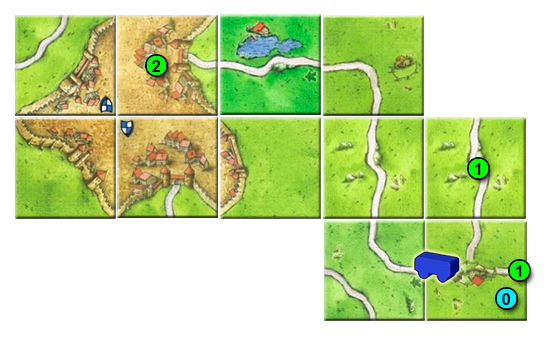
- 0 Tile just placed.
- 1 The wagon can move to any tile of these directly adjacent roads, because they are uncompleted and unoccupied.
- 2 The wagon can move to any of the tiles in the city because it is directly adjacent to the completed road (the city closes its left end), and it is uncompleted and unoccupied.
The Barn
Preparation
Each player should start the game with a Barn of their chosen colour.
Place A Tile
There are no tiles specific to The Barn.
Deploy a follower
The barn may be placed instead of a follower. It may only be placed on the point of intersection of four land tiles, one of which has just been placed by the player. The four land tiles must only consist of fields at this intersection point. [39] [24] [40] [41] [42]
The barn may also be placed on a farm on which there are already farmers, although not one on which there is already another barn. [43]
The barn will remain where it is until the end of the game. [44]
A barn cannot be removed by the dragon (from ![]() Princezna a drak (3. rozšíření)), nor taken prisoner by a tower (from
Princezna a drak (3. rozšíření)), nor taken prisoner by a tower (from ![]() Věž (4. rozšíření)).
Věž (4. rozšíření)).
Scoring
Scoring when placing the barn
Any farmers already on the farm are scored immediately, in the same way as at the end of the game. [45] [46]
That is, the player or players with the majority of farmers score the usual 3 points for every completed city. [47]
It makes no difference whether the owner of the barn is involved in scoring
or not. [48] When playing with ![]() Kupci a stavitelé (2. rozšíření), a player with a pig scores 4 points per city instead of 3 when scoring points for a farm. Then the players return the farmers (and pigs, if used) to their supply. The barn, however, remains. [49]
Kupci a stavitelé (2. rozšíření), a player with a pig scores 4 points per city instead of 3 when scoring points for a farm. Then the players return the farmers (and pigs, if used) to their supply. The barn, however, remains. [49]
Summary for use with other expansions:
If farmer majority –
- 3 points per completed city adjacent to farm
- 4 points per castle adjacent to farm
- +1 point per castle or completed city with pig (then return pig to owner’s supply)
- +1 point per castle or completed city with pig herd tile
Scoring when a farm is connected
No farmer may be deployed to a farm with a barn. [50] If the placement of a tile results in a farm with farmers being connected to a farm with a barn, the farmers are scored immediately. [45] [51] However, the player with the majority of farmers scores only 1 point for every completed city (with a pig: 2 points instead of 1). [52] These farmers (and pigs, if used) are then also returned to their owners after scoring.
Summary for use with other expansions:
If farmer majority –
- 1 point per completed city adjacent to farm
- 2 points per castle adjacent to farm
- +1 point per castle or completed city with pig
- +1 point per castle or completed city with pig herd tile
Final Scoring
At the end of the game, the owner of a barn scores 4 points for every completed city adjacent to the farm [53]
and 5 points for every castle adjacent to the farm. If several barns lie on a single farm through the placement of connecting tiles, each player receives the full score. The pig-herd tile (from ![]() Řeka II) does not generate any additional points for the barn. [54] [55]
Řeka II) does not generate any additional points for the barn. [54] [55]
Domácí pravidla
- Wagons are only allowed to be used in cloisters (and shrines) if the tile also contains a road. This means that the wagon cannot be used in an abbey. (Thanks to dwhitworth)
- The wagon can move to the next complete, or uncontested and incomplete, feature. This lets it roll across the board to uncontested features. (Thanks to viberunner)
- The mayor cannot be captured by the tower. (Thanks to viberunner)
- The wagon cannot be eaten by the dragon or captured by the tower. (Thanks to viberunner)
- The wagon can be used in ‘non-roaded’ features. It can move from the abbey to a touching city or road (one move, one turn) but it cannot do so from a cloister that touches only a farm. (Thanks to viberunner)
- The mayor is laid flat in the same way as farmers so that you can tell at a glance which cities contain mayors. (Thanks to Joff)
Seznam kartiček
Poznámky pod čarou
Vysvětlení ikonek najdete na této stránce.
- ↑
 Official status: The mayor and wagon are followers, subject to the usual rules of deployment and affecting the majority. The barn is a special figure, not a follower.
Official status: The mayor and wagon are followers, subject to the usual rules of deployment and affecting the majority. The barn is a special figure, not a follower.
- ↑
 In the case of the tile with the well and three roads, all of the roads have to be completed before scoring.
In the case of the tile with the well and three roads, all of the roads have to be completed before scoring.
- ↑
 With the three-way tile in Opatství a starosta, the length of the road (e.g. for the purposes of the Robber Baron) is the total number of tiles in the road, not simply the longest distance between two ends. The road has three ends which have to be closed, but the result is that it’s likely to be bigger.
With the three-way tile in Opatství a starosta, the length of the road (e.g. for the purposes of the Robber Baron) is the total number of tiles in the road, not simply the longest distance between two ends. The road has three ends which have to be closed, but the result is that it’s likely to be bigger.
- ↑
 In the examples for this expansion, the road with a tunnel does indeed count as being “broken” if one is using
In the examples for this expansion, the road with a tunnel does indeed count as being “broken” if one is using  Tunel expansion, in which case the tile contains two as yet unconnected tunnel openings.
Tunel expansion, in which case the tile contains two as yet unconnected tunnel openings.
- ↑
 If a player has an abbey left, draws the very last tile, and plays it to a feature where he or she has a builder, the abbey may be played on the second part of the double-turn (i.e. before the final round of abbey placement).
If a player has an abbey left, draws the very last tile, and plays it to a feature where he or she has a builder, the abbey may be played on the second part of the double-turn (i.e. before the final round of abbey placement).
- ↑
 The RGG edition clarifies this sentence by adding "(not the diagonals)".
The RGG edition clarifies this sentence by adding "(not the diagonals)".
- ↑
 The rules that restrict the placement of cloisters next to already placed shrines also restrict the placement of abbeys.
The rules that restrict the placement of cloisters next to already placed shrines also restrict the placement of abbeys.
- ↑
 This paragraph was added in HiG’s and RGG’s
This paragraph was added in HiG’s and RGG’s  Big Box 2, and actually contradicts an earlier FAQ (which stated that the abbey tiles couldn’t be placed once the last landscape tile was drawn).
Big Box 2, and actually contradicts an earlier FAQ (which stated that the abbey tiles couldn’t be placed once the last landscape tile was drawn).
- ↑
 When an abbey is played in this manner, a follower may be deployed to the abbey as usual. If the abbey is completely surrounded and thus immediately finished, the abbey is scored as in a normal turn. Then final scoring occurs. (5/2013)
When an abbey is played in this manner, a follower may be deployed to the abbey as usual. If the abbey is completely surrounded and thus immediately finished, the abbey is scored as in a normal turn. Then final scoring occurs. (5/2013)
- ↑
 The RGG edition has a slight change here, in that the final sentence of this section is moved here.
The RGG edition has a slight change here, in that the final sentence of this section is moved here.
- ↑
 When an abbey tile is placed, a follower cannot be deployed next to the abbey (as a knight, for example), as the abbey covers the whole tile. The surroundings are not a city. Thus, a follower on this tile is a monk.
When an abbey tile is placed, a follower cannot be deployed next to the abbey (as a knight, for example), as the abbey covers the whole tile. The surroundings are not a city. Thus, a follower on this tile is a monk.
- ↑
 A shrine can challenge an abbey, and vice versa, because the abbey is also a cloister.
A shrine can challenge an abbey, and vice versa, because the abbey is also a cloister.
- ↑
 If a player completes a feature with an abbey tile and his or her builder is on the feature, the feature does not get “extended” by the abbey (as the abbey is a separate feature), so the player does not get another tile.
If a player completes a feature with an abbey tile and his or her builder is on the feature, the feature does not get “extended” by the abbey (as the abbey is a separate feature), so the player does not get another tile.
- ↑
 Question: If cities with trade goods are completed by placement of an abbey tile, are the goods tokens awarded as usual to the player placing the abbey tile? Answer: Yes, as the player completed the city.
Question: If cities with trade goods are completed by placement of an abbey tile, are the goods tokens awarded as usual to the player placing the abbey tile? Answer: Yes, as the player completed the city.
- ↑
 The abbey also creates the boundary of a farm.
The abbey also creates the boundary of a farm.
- ↑
 A knight in a besieged city can escape via an abbey as well as a cloister, as the abbey has all the characteristics of a cloister.
A knight in a besieged city can escape via an abbey as well as a cloister, as the abbey has all the characteristics of a cloister.
- ↑
 Mayors and wagons can also escape a besieged city via cloisters and abbeys (although it would be quite amusing if the mayor stayed, like a captain going down with the ship).
Mayors and wagons can also escape a besieged city via cloisters and abbeys (although it would be quite amusing if the mayor stayed, like a captain going down with the ship).
- ↑
 Any follower, including the mayor, that is placed in a city is considered to be a knight.
Any follower, including the mayor, that is placed in a city is considered to be a knight.
- ↑
 The RGG edition of
The RGG edition of  Big Box 2 says instead “no knight or follower”. Some versions of the rules state “no knight or mayor,” but this is redundant, as the mayor is a knight (as is any other follower in a city). (updated 1/2015)
Big Box 2 says instead “no knight or follower”. Some versions of the rules state “no knight or mayor,” but this is redundant, as the mayor is a knight (as is any other follower in a city). (updated 1/2015)
- ↑
 The mayor cannot be placed into a city that already contains a wagon. Both are followers (according to the definition in the rules), so the city is already occupied by the wagon.
The mayor cannot be placed into a city that already contains a wagon. Both are followers (according to the definition in the rules), so the city is already occupied by the wagon.
- ↑
 The mayor can be a flier. However, the mayor can only land on an unfinished city. If an unfinished city is not available on the tile where the mayor lands, the mayor returns to the player’s supply. (2/2013)
The mayor can be a flier. However, the mayor can only land on an unfinished city. If an unfinished city is not available on the tile where the mayor lands, the mayor returns to the player’s supply. (2/2013)
- ↑
 The mayor can go through the magic portal. However, the mayor can only be placed in an unfinished and unclaimed city. (2/2013)
The mayor can go through the magic portal. However, the mayor can only be placed in an unfinished and unclaimed city. (2/2013)
- ↑ Jump up to: 23.0 23.1
 The mayor and the wagon can be eaten by the dragon, captured by the tower, and seduced by a princess. The mayor and the wagon can be placed in the appropriate quarter of Carcassonne. The mayor and the wagon can use a magic portal.
The mayor and the wagon can be eaten by the dragon, captured by the tower, and seduced by a princess. The mayor and the wagon can be placed in the appropriate quarter of Carcassonne. The mayor and the wagon can use a magic portal.
- ↑ Jump up to: 24.0 24.1 24.2
 Question: Can the mayor, the wagon, or the barn be placed on top of a tower? Answer: No, the deployment of these figures is limited to the features described in the rules.
Question: Can the mayor, the wagon, or the barn be placed on top of a tower? Answer: No, the deployment of these figures is limited to the features described in the rules.
- ↑
 The RGG edition inserts the following clarification: “For example, if the city has 3 pennants, the mayor counts as 3 followers.”
The RGG edition inserts the following clarification: “For example, if the city has 3 pennants, the mayor counts as 3 followers.”
- ↑
 The qualification about scoring no points is new in HiG’s
The qualification about scoring no points is new in HiG’s  Big Box 2, and confirms an earlier FAQ.
Big Box 2, and confirms an earlier FAQ.
- ↑
 Question: Blue has a mayor in a city with no pennants. Does the city count as occupied? And if so, when the city is scored, will Blue score points? Answer: The city is occupied. The mayor has no “strength,” so he counts as if there is no follower, and scores no points.
Question: Blue has a mayor in a city with no pennants. Does the city count as occupied? And if so, when the city is scored, will Blue score points? Answer: The city is occupied. The mayor has no “strength,” so he counts as if there is no follower, and scores no points.
- ↑
 A mayor could end up in a castle, and the castle would be considered to be occupied. However, because castles have no pennants (similar to the above footnote), the player would receive no points when the castle was completed, as the strength of the followers in the castle would be 0.
A mayor could end up in a castle, and the castle would be considered to be occupied. However, because castles have no pennants (similar to the above footnote), the player would receive no points when the castle was completed, as the strength of the followers in the castle would be 0.
- ↑
 Instead of "no other figure," this should read "no other follower".
Instead of "no other figure," this should read "no other follower".
- ↑
 The RGG edition changes “figure” to “no other wagon or follower.” This avoids confusion about the term “follower” but adds a distinction between “follower” and “wagon” which is not valid.
The RGG edition changes “figure” to “no other wagon or follower.” This avoids confusion about the term “follower” but adds a distinction between “follower” and “wagon” which is not valid.
- ↑
 Question: What is the definition of [connected/adjacent/neighboring] for the Wagon? If two city walls are touching (maybe even only at a point), can I drive my Wagon from one to another? Answer: “Connected” means roads which lead to crossings and roads which head directly “into” a city or a cloister. Two cities never connect to each other (in the current land tiles). City walls that touch at a point (such as at the corner of tiles) are not considered connected, so the wagon cannot travel from one to the other. Thus, the wagon has to use the roads to move. [Additionally, a road that touches a city at a point but not at a gate in the wall is not connected to the city. Also, a road running through a city via a tunnel is not connected to the city. – Chris O.] (confirmed 5/2013)
Question: What is the definition of [connected/adjacent/neighboring] for the Wagon? If two city walls are touching (maybe even only at a point), can I drive my Wagon from one to another? Answer: “Connected” means roads which lead to crossings and roads which head directly “into” a city or a cloister. Two cities never connect to each other (in the current land tiles). City walls that touch at a point (such as at the corner of tiles) are not considered connected, so the wagon cannot travel from one to the other. Thus, the wagon has to use the roads to move. [Additionally, a road that touches a city at a point but not at a gate in the wall is not connected to the city. Also, a road running through a city via a tunnel is not connected to the city. – Chris O.] (confirmed 5/2013)
- ↑
 The wagon cannot move directly from one city to the other on the tile shown above. There is a crossing between the two cities, and crossings belong to roads. Thus, for the wagon to move through the crossing, it would have had to have started on a road. The cities are not directly connected from wall to wall. The wagon cannot move to one of the “small roads”, either, as the rules clearly state that followers cannot be placed there. (8/2013)
The wagon cannot move directly from one city to the other on the tile shown above. There is a crossing between the two cities, and crossings belong to roads. Thus, for the wagon to move through the crossing, it would have had to have started on a road. The cities are not directly connected from wall to wall. The wagon cannot move to one of the “small roads”, either, as the rules clearly state that followers cannot be placed there. (8/2013)
- ↑
 The wagon cannot drive through any feature to get to another feature. Features are any aspect of the tile that can be claimed by a follower or that triggers a function, including cloisters, bazaars, crop circles, fairs, etc. [Note: this represents a reversal of a previous clarification. Previously, unclaimable structures such as fairs were not considered features and could be driven through to a road on the other side.] (5/2013)
The wagon cannot drive through any feature to get to another feature. Features are any aspect of the tile that can be claimed by a follower or that triggers a function, including cloisters, bazaars, crop circles, fairs, etc. [Note: this represents a reversal of a previous clarification. Previously, unclaimable structures such as fairs were not considered features and could be driven through to a road on the other side.] (5/2013)
 This means that the wagon cannot drive through any special thing on a tile, including the School.
This means that the wagon cannot drive through any special thing on a tile, including the School.
- ↑
 A wagon can be placed on an abbey. Additionally, the wagon can drive onto a directly connected city or road after scoring (and the other way round, from city/road to abbey), as long as the target feature has not yet been completed. (confirmed 5/2013)
A wagon can be placed on an abbey. Additionally, the wagon can drive onto a directly connected city or road after scoring (and the other way round, from city/road to abbey), as long as the target feature has not yet been completed. (confirmed 5/2013)
- ↑
 The wagon can be moved from a city to a cloister that is within that city (or vice versa), as roads are not required for a “connection,” just a shared wall/edge/surface. (confirmed 5/2013)
The wagon can be moved from a city to a cloister that is within that city (or vice versa), as roads are not required for a “connection,” just a shared wall/edge/surface. (confirmed 5/2013)
- ↑
 When moving a wagon to a new feature, the player can choose which tile to set it on. For example, if moving the wagon from a city to a road which so far consists of five tiles, the wagon can be placed on any of those tiles, not just the first tile that it gets to. For scoring this doesn't matter, but if a dragon or the plague happens to come by, the exact placement will make a big difference.
When moving a wagon to a new feature, the player can choose which tile to set it on. For example, if moving the wagon from a city to a road which so far consists of five tiles, the wagon can be placed on any of those tiles, not just the first tile that it gets to. For scoring this doesn't matter, but if a dragon or the plague happens to come by, the exact placement will make a big difference.
- ↑
 The RGG version adds the following clarification: "A wagon always counts as though it were a follower during scoring."
The RGG version adds the following clarification: "A wagon always counts as though it were a follower during scoring."
- ↑
 Question: Can you deploy a wagon to a city, score it, and then move the wagon to another feature, all in one turn? Or can you only move the wagon instead of deploying a normal follower? Answer: The wagon can be deployed instead of a normal follower. If the city is immediately completed, then it’s scored (wagon or “normal” follower). After scoring, the wagon can be moved. All of that is possible in a single turn. [Wagon movement is not in place of deployment.]
Question: Can you deploy a wagon to a city, score it, and then move the wagon to another feature, all in one turn? Or can you only move the wagon instead of deploying a normal follower? Answer: The wagon can be deployed instead of a normal follower. If the city is immediately completed, then it’s scored (wagon or “normal” follower). After scoring, the wagon can be moved. All of that is possible in a single turn. [Wagon movement is not in place of deployment.]
- ↑
 The barn cannot be placed in the City of Carcassonne. The barn cannot use a magic portal.
The barn cannot be placed in the City of Carcassonne. The barn cannot use a magic portal.
- ↑
 The barn can be placed on a tile with a volcano.
The barn can be placed on a tile with a volcano.
- ↑
 The fairy cannot be placed next to the barn, as the barn is not a follower.
The fairy cannot be placed next to the barn, as the barn is not a follower.
- ↑
 The barn cannot be placed at an intersection with mist banks, since they separate fields.
The barn cannot be placed at an intersection with mist banks, since they separate fields.
- ↑
 The RGG edition omits this last sentence about other barns.
The RGG edition omits this last sentence about other barns.
- ↑
 The barn can, however, be removed by a Festival tile. (12/2014)
The barn can, however, be removed by a Festival tile. (12/2014)
- ↑ Jump up to: 45.0 45.1
 The word “immediately” here means that farmers are scored then removed during the normal scoring phase of this turn (as opposed to staying on the farm until the end of the game). The placement of a barn does not stop play for a separate scoring phase for the farmers. Thus, the normal “move wood” portion of the turn occurs before the farmers are scored. (10/2012)
The word “immediately” here means that farmers are scored then removed during the normal scoring phase of this turn (as opposed to staying on the farm until the end of the game). The placement of a barn does not stop play for a separate scoring phase for the farmers. Thus, the normal “move wood” portion of the turn occurs before the farmers are scored. (10/2012)
- ↑
 Placing of a barn, and the subsequent scoring of the farm, does count as an opportunity to remove a follower from Carcassonne. Now that farms can be scored at times other than at the end of the game, followers from the market can be moved to farms earlier in the game. That occurs immediately after the placement of the barn, and before the farmers are scored. [Joining of a farm containing a follower to a farm with a barn would logically be another opportunity – Chris O.]
Placing of a barn, and the subsequent scoring of the farm, does count as an opportunity to remove a follower from Carcassonne. Now that farms can be scored at times other than at the end of the game, followers from the market can be moved to farms earlier in the game. That occurs immediately after the placement of the barn, and before the farmers are scored. [Joining of a farm containing a follower to a farm with a barn would logically be another opportunity – Chris O.]
- ↑
 A besieged city does still score double points if it lies on a farm with a barn.
A besieged city does still score double points if it lies on a farm with a barn.
- ↑
 Question: If I place a barn on a farm on which another player has farmers, causing him/her to score while I score nothing, can I move a follower to Carcassonne? (While there is no immediate score to me now, the barn is certain to score at the end of the game). Answer: Yes, that’s allowed. Only immediately scored points matter.
Question: If I place a barn on a farm on which another player has farmers, causing him/her to score while I score nothing, can I move a follower to Carcassonne? (While there is no immediate score to me now, the barn is certain to score at the end of the game). Answer: Yes, that’s allowed. Only immediately scored points matter.
- ↑
 The RGG edition added this last sentence.
The RGG edition added this last sentence.
- ↑
 The RGG version further clarifies this as follows: "There may only be one barn on each farm. Of course, connecting two farms, each with a barn, is quite legal."
The RGG version further clarifies this as follows: "There may only be one barn on each farm. Of course, connecting two farms, each with a barn, is quite legal."
- ↑
 Because this joining of farms is a scoring situation, a follower can be moved from Carcassonne to the farm with a barn. The farmer will be scored immediately, and so scores only 1 point per city and is (importantly) not on the farm during the final scoring proper.
Because this joining of farms is a scoring situation, a follower can be moved from Carcassonne to the farm with a barn. The farmer will be scored immediately, and so scores only 1 point per city and is (importantly) not on the farm during the final scoring proper.
- ↑
 Question: May the pig be placed on a farm that was just connected to a farm with a barn, i.e. on the newly placed tile (immediately before scoring)? Answer: Yes, the pig may be placed in already occupied features [and, as above, the normal “move wood” phase still happens].
Question: May the pig be placed on a farm that was just connected to a farm with a barn, i.e. on the newly placed tile (immediately before scoring)? Answer: Yes, the pig may be placed in already occupied features [and, as above, the normal “move wood” phase still happens].
- ↑
 The RGG edition adds "regardless of their distance from the barn". This is probably to help introduce players to 3rd edition scoring.
The RGG edition adds "regardless of their distance from the barn". This is probably to help introduce players to 3rd edition scoring.
- ↑
 The last sentence is new to the
The last sentence is new to the  Big Box 2 and confirms an earlier FAQ. The statement is not in
Big Box 2 and confirms an earlier FAQ. The statement is not in  Big Box 3, presumably because
Big Box 3, presumably because  Řeka II is not included in this collection.
Řeka II is not included in this collection.
- ↑
 The pig-herd tile can score an extra point per city when there is a barn on the farm.
The pig-herd tile can score an extra point per city when there is a barn on the farm.
